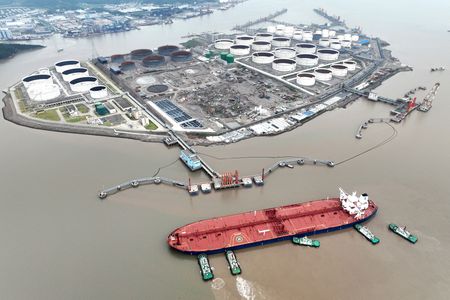
By Sonali Paul and Jeslyn Lerh
SINGAPORE (Reuters) -Oil prices climbed on Friday on bets that OPEC+ will discuss output cuts at a meeting on Sept. 5, though benchmarks were on track for a steep weekly decline as fears of China’s COVID-19 curbs and weak global growth weighed on the market.
Brent crude futures rose $1.68, or 1.8%, to $94.04 a barrel at 0330 GMT, while U.S. West Texas Intermediate (WTI) crude futures jumped $1.66, or 1.9%, to $88.27 a barrel.
Both benchmark contracts slid 3% in the previous session to two-week lows. Brent was headed for a weekly drop of nearly 7%, and WTI was on track to fall about 5% for the week.
The Organization of the Petroleum Exporting Countries and allies, together called OPEC+, are due to meet on Sept. 5 against a backdrop of sliding prices and falling demand, even as top producer Saudi Arabia says supply remains tight.
ANZ commodities analyst Daniel Hynes said it might be a bridge too far for OPEC+ to agree to cut output but that top producer Saudi Arabia will likely highlight what it sees as a disconnect between current prices and tight supply fundamentals.
“They will certainly try to talk up the market as much as possible to better reflect what they see as a tight market, which is exposed to further supply side issues,” he said.
OPEC+ this week slashed its demand outlook, now forecasting demand to lag supply by 400,000 barrels per day (bpd) in 2022, but it expects a market deficit of 300,000 bpd in its base case for 2023.
“We expect the group to leave output targets unchanged. Their own numbers show a tighter-than-expected market and they would probably also want some more clarity on Iranian supply before making any big changes to output policy,” said Warren Patterson, head of commodity research at ING.
Meanwhile, investors remain worried about the impact of the latest COVID-19 curbs in China. The city of Chengdu on Thursday ordered a lockdown that has hit manufacturers like Volvo.
“Oil prices have been facing a confluence of headwinds lately, with recent virus lockdowns in China coming after its lacklustre PMI readings pointing to a lower-for-longer growth picture and puts demand outlook at risk,” said Yeap Jun Rong, market strategist at IG.
Data showed Chinese factory activity in August contracted for the first time in three months amid weakening demand, while power shortages and COVID-19 outbreaks disrupted production.
(Reporting by Sonali Paul in Melbourne and Jeslyn Lerh in Singapore; Editing by Tom Hogue)

